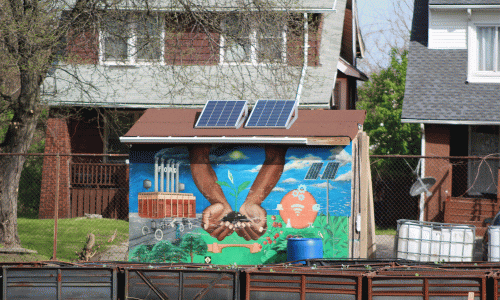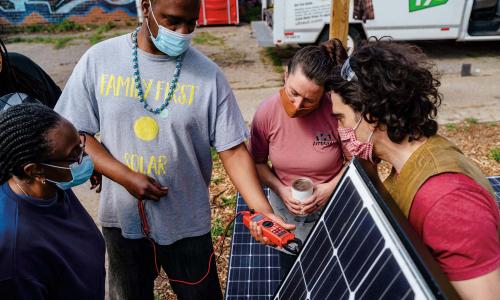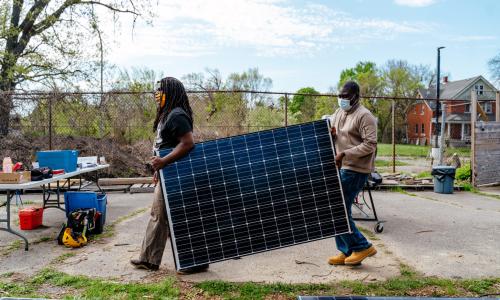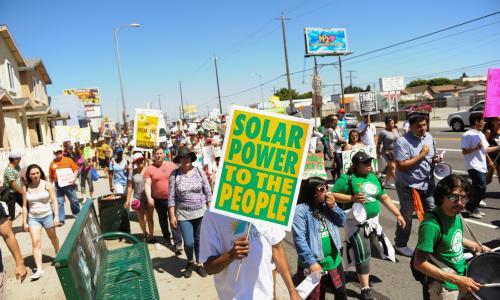In Highland Park, Michigan, the energy education and advocacy organization Soulardarity has a vision of energy sovereignty: a community powered by resilient, affordable clean energy resources, owned by Highland Park residents and businesses.
To that end, this analysis by the Union of Concerned Scientists and Soulardarity shows how solar power, energy efficiency, and other local resources can meet 100 percent of the community’s electricity demand. Changes in public policies can make the vision not only possible but affordable for Highland Park as well as other communities across the United States. Empowering local communities to choose clean energy can and should play a key role in overall decarbonization efforts in Highland Park, in Michigan, and across the country.
Update: As a follow-up to Let Communities Choose, we conducted a case study to analyze possibilities for a solar-plus storage microgrid serving the Parker Village neighborhood in Highland Park. Using an energy system model and an estimate of local electricity use, we present this case study as an example for other neighborhoods and communities to consider when exploring their own microgrid options.
Let Communities Choose
This is a condensed, online version of the report. Access to all figures and full report are available through download of the PDF.
In the traditional model for electric utilities, we all use the power they supply and we pay the bills; the utilities do the rest. This model is not designed to engage the people and communities the utilities serve, nor does it provide quality service for all. Rather, it heightens the health, affordability, and climate crises that affect people already struggling with too many service outages, rising electricity rates, and downed power lines.
This is felt deeply in Highland Park, Michigan, where residents are asking fundamental questions. What if we envision a different model of supplying and consuming electricity? What if we empower communities to choose clean energy and generate electricity locally?
Increasingly, communities across the United States are doing just that. As the climate crisis accelerates, people of color and low-income working-class people, afflicted by historic systemic racism, are experiencing some of the worst effects of pollution and climate change. Fossil fuel generators that burn coal and methane gas are disproportionately sited in or near low-income and minority communities, contaminating the environment, posing health risks, and driving up carbon emissions (Grier, Mayor, and Zeuner 2019). That is a big reason why more and more neighborhoods and entire cities are demanding the development of clean energy that leads to safe, resilient, affordable, and community-driven systems. As interest in reimagining the energy system increases, communities are seeking the agency to choose locally generated electricity resources that benefit everyone and provide access to all (Schelly et al. 2020).
The Union of Concerned Scientists (UCS) and Soulardarity (a Highland Park–based nonprofit working to build a just and equitable energy system for all) set out to explore how Highland Park could envision a future of clean energy and move to a locally controlled, equitable, and just energy system—a community powered 100 percent by local, resilient, and affordable clean energy sources, owned by local people and businesses. Let Communities Choose explores a potential pathway to achieving the bright, resilient vision this city’s residents have for their community. It considers the policy changes and the modifications to a traditional utility’s incentives and ways of operating that are needed to achieve that vision and its emphasis on an equitable distribution of benefits.
Places like Highland Park are seeking energy sovereignty—the ability of communities and individuals to choose the forms, scales, and sources of the energy they use (Schelly et al. 2020). This should be a core building block as Michigan, other states, and the nation seek not only to decarbonize the provision of electricity and other services but also to address how those services reflect systemic racism.
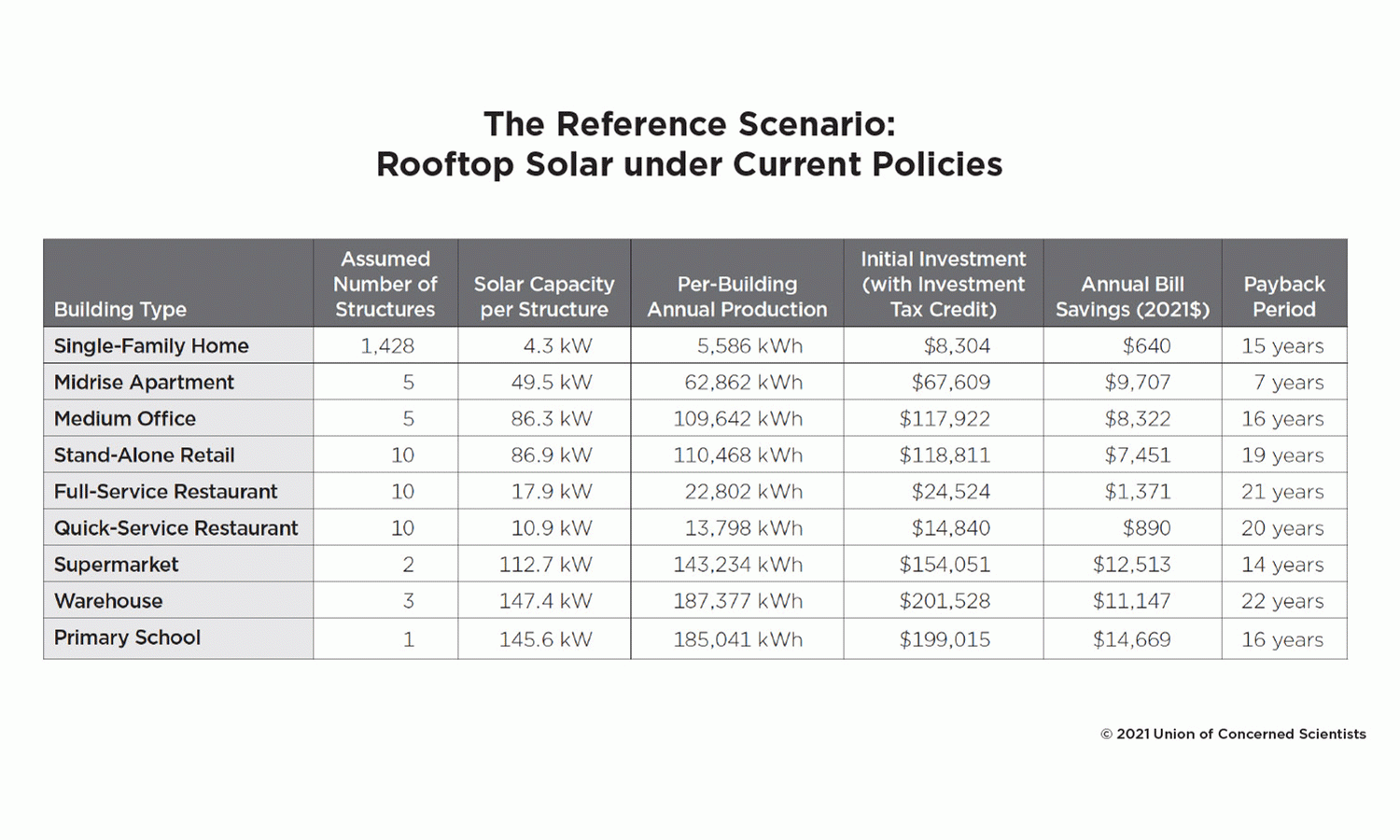
Achieving Self-Determination in Highland Park
In Highland Park, a 2.97 square mile city in Southeast Michigan, today’s roughly 10,000 residents represent about one-fifth of its peak population of 53,000 (City of Highland Park, n.d.). The city has been ground zero for the fossil fuel model of community development. In addition to Henry Ford’s creation of the world’s first moving assembly line in 1913 (Detroit Historical Society, n.d.), the city and its immediate vicinity have been home to the country’s first mile of concrete highway (1909) and first depressed urban expressway (1942) (MDOT 2015).
Today, innovative, dedicated local leaders in this community are fighting for just and equitable development in the face of numerous systemic crises. According to University of Michigan researchers, Highland Park is in the 92nd percentile for environmental injustice in Michigan, with among the highest levels of health vulnerability based on hazardous air pollution, poverty, and other social and environmental determinants (Zeuner, Grier, and Mayor 2019).
Income is extremely low, with 46.5 percent of the population living at or below the poverty level. Median household income is $18,474; 63 percent of residents are renters; and the median value of owner-occupied housing units is $45,700 (US Census Bureau 2019). Highland Parkers struggle with the impacts of aging and divested housing stock, food insecurity, burdensome housing costs, and a lack of Internet access (less than 50 percent of households have broadband connection).
Highland Parkers also suffer from extreme “energy poverty.” The average Michigan household that has the median income of Highland Park spends 18 to 33 percent of income on energy; 6 percent or less is considered to be an affordable energy burden (Fisher Sheehan & Colton, n.d.). In part, this deficit is driven by consistent and aggressive increases in residential electric rates from DTE Energy, the local utility, while rates for industrial and other large energy users have risen much more slowly (Matheny 2019). Some Highland Parkers also experience very poor energy reliability: some households reported multiple full days of outages this past year, including during heat waves, winter storms, and pandemic conditions (House 2021).
Despite the historic forces stacked against them, Highland Parkers have organized for transformative and forward-thinking changes, and they are claiming a seat at the table in state and federal policy conversations on various important topics such as lead and copper rules, utility regulation, and community development. In 2011, when DTE Energy repossessed and removed two-thirds of the city’s streetlights, residents responded by forming Soulardarity, a nonprofit organization that has since installed 17 community-owned, solar-powered streetlights and has become a strong advocate for energy democracy. At the same time, two Highland Parkers launched sustainable development projects, Avalon Village and Parker Village, that advance community-centered sustainable development visions anchored by clean energy (Avalon Village, n.d.; Parker Village, n.d.). In 2019, Soulardarity released The Blueprint for Energy Democracy, a plan to make Highland Park a global model for sustainability and self-determination (Soulardarity 2019).
Toward an Energy Sovereignty Vision
Soulardarity’s vision for Highland Park is a community powered 100 percent by local, resilient, and affordable clean energy resources that are owned by people and businesses in the community. UCS and Soulardarity started their analysis of how to make this possible with an assumption that Highland Park’s residential and commercial sectors have a total average annual electricity demand of approximately 86,200 megawatt-hours (MWh) (Buchanan et al. 2017). What collection of resources could meet that level of demand, with a particular focus on the capacity and economics of rooftop solar? This analysis focused on the electricity sector and identified key resource categories to serve Soulardarity’s vision of energy sovereignty.
-
Energy efficiency: The foundation of the vision is energy efficiency, which reduces the amount of electricity consumed while lowering energy bills and improving the comfort, health, and longevity of homes and businesses.
-
Rooftop solar: Hosting solar panels on the roofs of homes and other buildings can reduce both customers’ electricity bills and the amount of land needed for electricity generation. Rooftop solar makes more space available for urban agriculture, recreation, and other community and economic purposes. It can also be paired with energy storage batteries to further help customers save money on their bills and to assist during power outages and periods of peak power demand (see box).
-
Community solar facilities: Larger yet still local solar installations enable subscribing customers to receive credit on their electricity bills for the electricity produced. This model is particularly advantageous for residents or businesses unable to pursue rooftop solar, either because they are renters or because their roofs cannot accommodate solar.
-
Other distributed solar resources: Throughout a community, customer-owned solar can be installed in innovative ways and locations that take up little land. For example, solar carports can include charging hookups for electric vehicles, solar canopies can be installed over driveways, patios, or other outdoor areas, and solar trees in various shapes and sizes can be located on business grounds or in parks or other public spaces.
-
Community water and energy resource centers (CWERCs): CWERCs are small-scale treatment facilities (1 million to 5 million gallons daily) that accept wastewater from sewer pipes and food waste from food processors and local businesses, converting it to electricity, reclaimed water, and thermal energy (CRWA 2015). CWERCs turn organics into methane through anaerobic digestion, which can be used to generate electricity and heat.
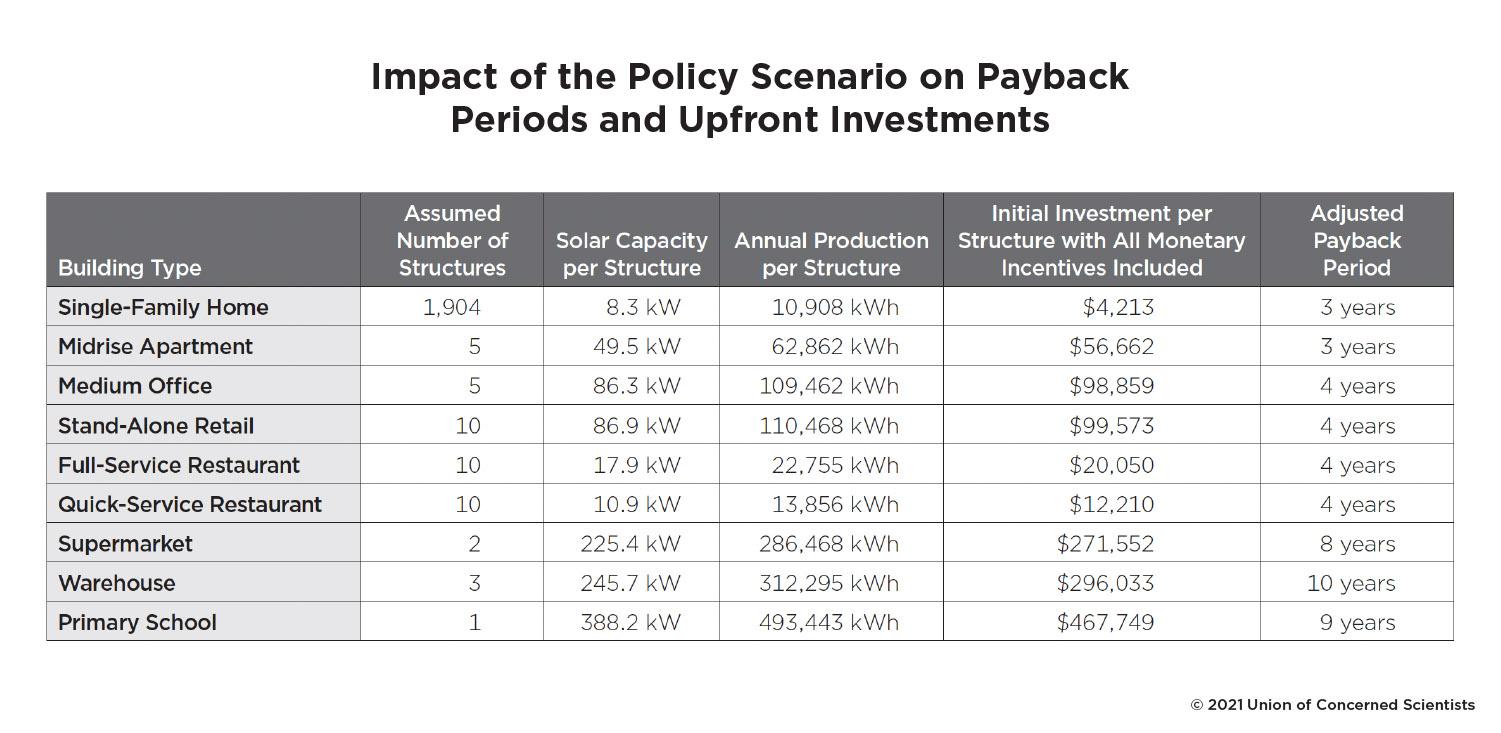
Rooftop Solar Analysis
Our analysis used the Hybrid Optimization of Multiple Energy Resources (HOMER) software model to examine Highland Park’s potential for rooftop solar under current policies and programs maintained in Michigan and by DTE. The analysis included nine types of buildings.
Residential single-family homes are the most prevalent structures in Highland Park. Using census data, we estimated the number of occupied single-family homes in Highland Park. We then assumed that about 60 percent of these homes are currently solar-viable based on aggregated overhead imagery (Google Project Sunroof 2018) and input from our project team about the structural conditions of houses. The eight other structure types examined were midrise apartment, medium-size office, stand-alone retail, supermarket, warehouse, primary school, and full-service and quick-service restaurant buildings.
We then developed a reference scenario, selecting the largest solar configurations from the HOMER outputs based on rooftop size and the requirements in DTE’s distributed generation program (Table 1). In general, we found that single-family homes and certain other building types are limited in the amount of solar they can install because of the utility’s restriction tying the size of a solar installation to a customer’s annual usage and an overall limit of 150 kilowatts (kW). Also, payback periods are relatively long due in part to DTE’s compensation mechanism for customer-generated solar power and the absence of other state solar incentives.
We found that installing solar in the amounts in our reference scenario (Table 1) would produce 11,343 MWh per year. This would meet about 13 percent of Highland Park’s energy needs.
For additional detail on the methodology, see the technical appendix at www.ucsusa.org/resources/let-communities-choose-clean-energy.
We created a policy scenario to test how improved solar policies could increase the potential for rooftop solar in Highland Park. The scenario has four components:
-
Eliminating size restrictions on distributed generation: Assuming that the owners of homes and other buildings could utilize more of their rooftop space for solar generation, we selected larger solar systems from the HOMER outputs for building categories including single-family homes, supermarkets, warehouses, and primary schools. We also assumed that energy-efficiency retrofit programs would make additional single-family homes solar-viable, so that 80 percent of homes become available to host rooftop solar, rather than 60 percent.
-
Improving the compensation mechanism for solar production: In 2016, Michigan changed its energy laws to no longer require utilities to offer full retail-rate net metering. Until that change was implemented, every kilowatt-hour (kWh) a customer’s solar installation exported to the grid earned them a 1 kWh credit on their bills. Restoring full retail-rate net metering would significantly shorten payback periods for solar investments by single-family households compared with the period under DTE’s current compensation mechanism. The effect of restoring full retail-rate net metering could also be achieved by creating a fair and reasonable value-of-solar calculation; Minnesota uses such an approach (MnSEIA, n.d.).
-
Adding a supplemental revenue stream for customer solar production: Many states further compensate utility customers for solar generation. One form this can take is using a renewable portfolio standard (RPS) that recognizes the environmental attributes of solar and other clean energy resources. Michigan’s RPS, established in 2008, is 15 percent by 2021; compliance is achieved through utilities’ retiring what are known as renewable energy credits (RECs). One REC represents 1 MWh of renewable energy. As a proxy for additional solar compensation, our modeling assumes that Michigan updates and expands its RPS to include a distributed solar carve-out, as Illinois and several other state RPS programs have done; this could help create a viable solar REC (SREC) market for customers installing solar. Our policy scenario assumes that Highland Park solar owners could sell SRECs valued in the $42 to $67 range depending on the system size (equating to $0.042–$0.067 per kWh), payable upfront or shortly thereafter for 15 years of production, based on the Illinois program (Illinois Power Agency 2020).
-
Adding a Michigan Residential Energy Credit: State tax policy can incentivize rooftop solar. For example, the Massachusetts Department of Revenue regulations (Mass. Regs. Code tit. 830, § 62.6.1) offers a credit against state personal income taxes equal to 15 percent of the net expenditure for renewable energy resources (including batteries) or $1,000, whichever is less. Our policy scenario assumes that new solar customers in the single-family-home category would receive a $1,000 state tax credit or a cash grant if the customer has no tax liability.
This suite of policies could significantly reduce the payback period for installing a 4.3 kW solar system (Figure 1). With all four policy changes, the contribution of rooftop solar in our analysis increases from supplying about 13 percent of Highland Park’s electricity needs to supplying nearly 30 percent of the 86,200 MWh target. Further, both the payback periods and the needed upfront investments shrink substantially (Table 2).
This is a condensed, online version of the report. Access to all figures and full report are available through download of the PDF.
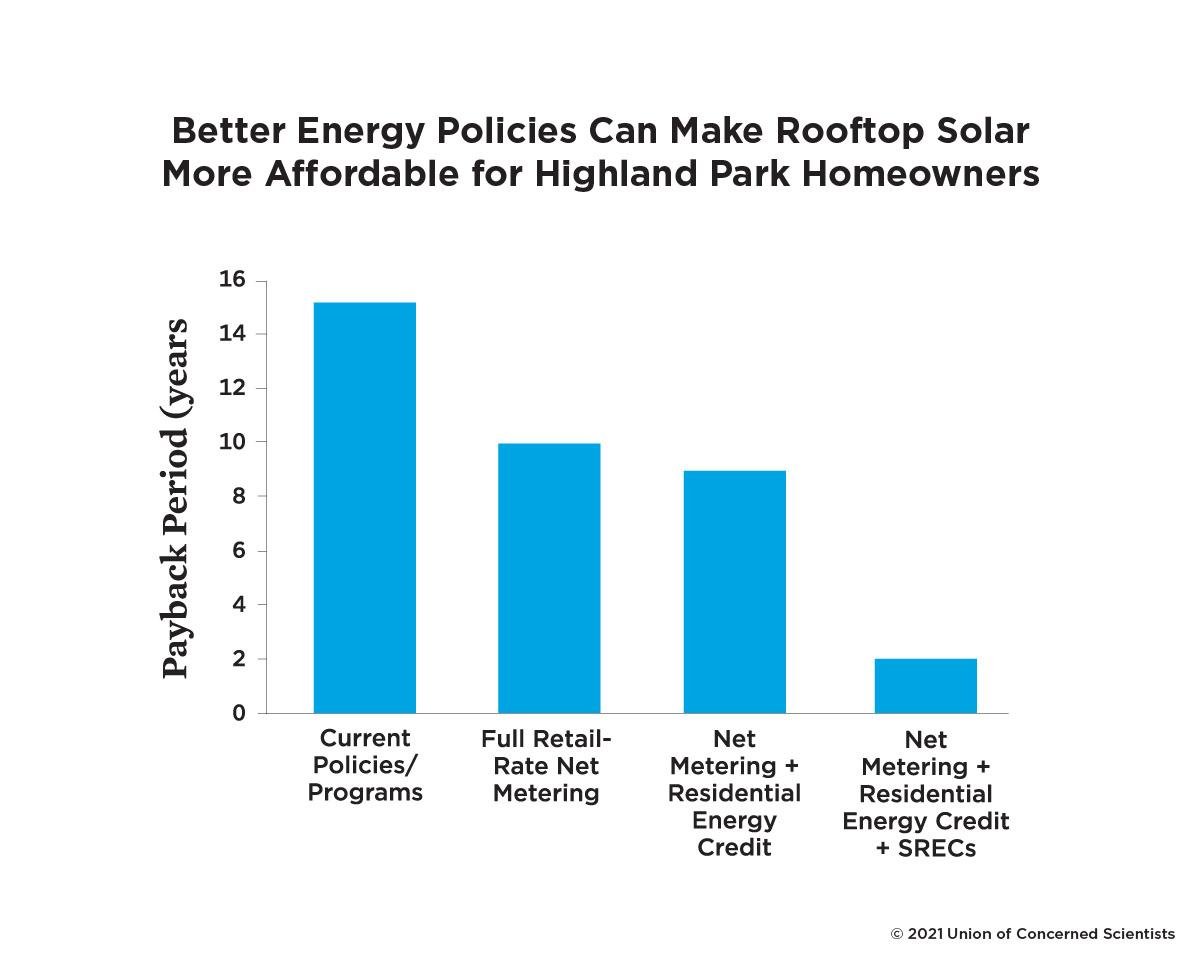
Citation
Gignac, James, Youngsun Baek, Jackson Koeppel, Shimekia Nichols, and Edyta Sitko. 2021. Let Communities Choose: Clean Energy Sovereignty in Highland Park, Michigan. Cambridge, MA: Union of Concerned Scientists and Soulardarity. https://ucsusa.org/resources/let-communities-choose-clean-energy.
Baek, Youngsun, James Gignac, and Juan Shannon. 2022. Designing a Neighborhood Microgrid. Cambridge, MA: Union of Concerned Scientists. https://ucsusa.org/resources/let-communities-choose-clean-energy.
